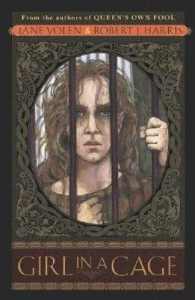 Girl in a Cage
Girl in a Cage is a historical novel about Marjorie Bruce—princess of Scotland and daughter of Robert the Bruce. It’s told in journal-like entries about her current caged situation interspersed with narrative flashbacks about what led up to it. According to authors Jane Yolen and Robert Harris, the story fills in gaps in what history tells us—it’s better at introducing readers to people they might want to learn more about than it is at educating readers about historical events.
It’s an engaging read—Marjorie is eleven years old when she gets caught up in Scotland’s fight for freedom. She’s a child growing up quickly as her world spins out of control, and it’s interesting to see the people and situations through her eyes. King Edward is pretty clearly the unmitigated villain, which I suppose makes sense from Marjorie’s point of view. The author’s note at the end, which puts the novel into historical context, also turns King Edward into a more nuanced character.
Marjorie very much begins as a little girl—suddenly a princess with beautiful dresses, a doting family (particularly her favorite uncle), and dreams of living in a palace. Through the course of the book, she realizes that a crown doesn’t make her father king nor her stepmother queen—they deserve those titles because of the responsibilities they’re willing to take on and the sacrifices they are willing to make for Scotland and her people. By the end of the story, Marjorie is filthy, in rags, and nearly starved to death—but she knows she is a princess of Scotland because she hasn’t buckled to King Edward even when he offers to make her life more comfortable. She’s also reached out to some of the people in the town, earning their respect and enabling them to stand against the king to protect her from death.
It’s not a tragic story—in fact, in some ways it’s uplifting because Marjorie’s courage inspires others—but it’s not really a happy story, either. By the end of the novel her situation is much improved, but not exactly all tied up in a neat bow like you’d expect a purely fictional ending to be. Readers wanting justice or white knights are likely to be unsatisfied.
SPOILER ALERT: Things you might want to know before suggesting this to your kid
Violence/Death
It’s a war. Plenty of people die, but mostly off screen. We see and hear the aftermath of some skirmishes and learn second hand of the gruesome fates of some characters. After Marjorie’s favorite uncle is hanged, drawn, and quartered, the reader learns just what that means—it’s factual but not overly graphic. A monk is lashed somewhat vividly, but this isn’t gratuitous—he’s punished for helping Marjorie, and she watches his punishment because she feels responsible for it.
Stereotypes
Marjorie’s father is a caring and loving figure, which seems atypical of an ancient king. Marjorie’s stepmother seems cold at first, but as the plot progresses, Marjorie comes to appreciate her stepmother’s grace and strength. Their final scene together is touching. Another primary character is Isabel, a female warrior who Marjorie idolizes but eventually sees as human and fallible. Marjorie also makes some of the peasant children part of her “court” and realizes that their impoverished lives aren’t much better than hers—although at least they aren’t in actual cages.
Religion
Marjorie often prays, but her faith is primarily a part of her and not a theme of the book as there’s no discussion of whether or how God does or doesn’t answer those prayers. She is kept outside a priory, and whether the brothers will obey God or the king is a significant subplot. There’s also some discussion about whose side God can be on, since both the Scottish and English pray to the same God, but more questions are raised than answered.
Abuse/Neglect
Well, it’s called Girl in a Cage and that’s where Marjorie spends most of the book. Townspeople pelt her with rotten vegetables. King Edward torments her mentally. Her clothes disintegrate into rags, she has very little food, and no one is permitted to talk to her. Toward the end of the book she nearly starves to death, and the description is pretty haunting. But her courage through it all makes the book a compelling read.
Recommendation
For kids ages 8 and up who are interested in history, this is a good choice. It also provides some insight into a real life princess who shows courage and intelligence in the face of hardship. Kids who are particularly sensitive to themes of abuse may have issues with it, though.
I think my 11 year old daughter will enjoy it, but I’ll also be gearing myself up to discuss lots of questions about the fight for Scottish independence, starvation, drawing and quartering, and how people can be so awful to each other. She’ll be much more intrigued by it because it’s based on real events, but also more affected by it. I think she’ll want to know a lot more about the time period and the people involved, so I’ll want to have resources on hand.
Girl in a Cage by Jane Yolen and Robert Harris
Published in 2004 by Speak
Stands alone but is the second novel in the Stuart Quartet: Queen’s Own Fool, Prince Across the Water, and The Rogues
Read personal copy found in a used book store





Speak Your Mind